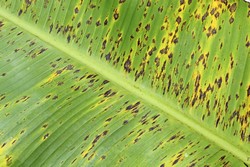Genetics of aggressive banana pathogens
Adaptive evolution describes how organisms become better suited to their surroundings over time, as beneficial genetic mutations are carried over to the next generation. The fungal pathogen Mycosphaerella fijiensis, which causes disease in bananas, is ideal for studying this process since it rapidly adapts to changing environments. The EU-funded GATFUN (Genetic basis of host adaptative traits in the plant pathogenic fungus Mycosphaerella fijiensis) project aimed to determine which genes are behind M. fijiensis' adaptation to overcome host defences. Researchers carried out genetic analyses to create a genetic map with about 370 genetic makers. The map will be used to identify genes related to aggressiveness traits. A phylogenetic tree was also constructed to infer population structure. The project team detected more diversity in the disease centre of origin (Asia) and traces of a serial bottleneck in the other regions. This data can now be used to compare native and recently introduced populations of the pathogen. Determining which genes are being selected by the host to allow M. fijiensis to thrive will aid efforts to control disease outbreaks in banana crops. In addition, this work will contribute to knowledge of how adaptive evolution works in fungi and other organisms.







